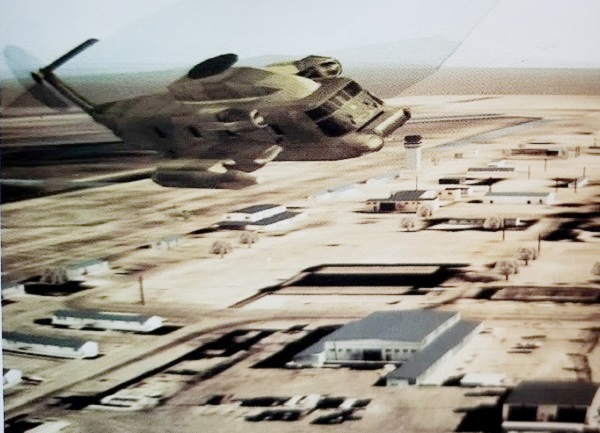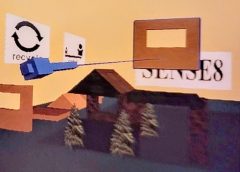It was Spring 1990 when Gullichsen and Gelband brought one of the few VR systems in the world to Intel for a demonstration. A researcher in Intel’s CAD group, Kenneth Pimentel had arranged for the demonstration as part of a project he was pursuing. After setting up the system, everyone in attendance had a chance to explore Sense8’s strange new worlds.

By carefully lowering a hand-tooled HMD over your face, you suddenly found yourself in a fuzzy checkerboard world. Dual Amiga computers, encased in surplus ammo canisters, generated cartoon-like images of buildings and a large sphere hanging in space. As you moved your head to look around, more of this strange world was revealed. Grabbing a baseball-sized device mounted on a small platform and pushing it in the appropriate direction sent you flying through the virtual world. After learning to drive with the odd, rubber-coated ball, you could fly into a hanger-like structure that abruptly transported you to yet another intriguing world.
The purpose of the visit to Intel was to pick a VR vendor to collaborate on a VR system based on Intel’s DVI (Digital Video Interactive) technology. Pimentel had recently received an Intel Applications Fellowship, giving him six months and $100,000 to develop a VR solution based on Intel products. After meetings with VPL, Autodesk, and the Human-Interface Technology Lab in Seattle, Washington, Pimentel selected Sense8 because they alone appeared capable of delivering a prototype within the six-month deadline. Also important was the hardware independence of their toolkit, plus it was already running on multiple platforms, it spoke volumes for the system’s portability
Working at Intel during the acquisition of DVI Technology from RCA’s David Sarnoff Research Center, Pimentel had a unique opportunity to learn about the multiple capabilities of this revolutionary chipset. The engineers at Sarnoff had developed a set of microcode programmable graphics chips, unlike any others. Their capabilities were determined by the microcode they were currently running In addition, a parallel architecture allowed multiple instructions to be executed in a single clock cycle-advanced features relative to other graphics controllers at the time.

Not only could the chipset perform decompression of moving images, allowing 72 minutes of full-screen, full-motion video from a single 3.5-inch compact disk (which is breathtaking when you think about it), it could also be programmed to draw graphics or textures. Texture mapping is particularly important when it comes to making a believable virtual environment. A photograph is first scanned into the computer and loaded into the DVI graphic board. Next, the digital image is “mapped” or reshaped to a different position on the screen. Utilizing this in a real-time 3-D rendering turns the normally cartoonish world into a realistic model.
Because a lot of scanned images could be stored in the DVI board, a 3-D world could be created rich in detail. Wooden floors, stone fireplaces, pictures on the walls, and rugs on the floor were all possible. Architects could have an interactive rendering tool that represented the world the way it really is, with complex images and textures wherever you look, many of the methods which are still used today (only in much higher resolutions).
Recognizing the potential of DVI products to add a completely new level of realism to virtual worlds, Intel approved funding to pursue developing a PC-based VR system. Working with DVI microcode experts back in Princeton to optimize the rendering algorithms resulted in significant performance gains. Months were spent integrating the new texturing capability with Sense8’s core code.
For two days, attendees waited hours in line for an opportunity to try it. The demonstration represented a breakthrough in PC realism and rendering performance for virtual worlds and virtual reality as a technology. Sense8 was clearly onto something and developed plans for marketing a product based on the DVI chip set’s capabilities.
At this point, Gullichsen and Gelband had created an impressive set of core technologies that could be accessed through an elegant and powerful set of programming function calls. Recognizing that it was impossible to predict which industries would represent the largest market for VR, they decided to create a general-purpose development tool. Any industry could then create their own unique tools based on the Sense8 technology this spreading the uses of VR beyond what a single company could do.
In June 1991, Sense8 ‘s WorldToolkit became commercially available. Intended for programmers, it contained a C-library of over 200 functions and a powerful simulation manager that allowed rapid prototyping of custom applications. 3-D models created with AutoCAD software, or any 3-D modeller that generated DXF files, could be read as objects or stationary backdrops. Device drivers were included for everything from simple mice and joysticks to Polhemus trackers and Spaceballs.
The commercial availability of WorldTool Kit represented a dramatic reduction in the cost of VR. Now it was possible to assemble a complete system for less than $25,000, or a third of the cost of competing platforms. In fact, by the end of 1991, the cost was down to $20,000 and dropping fast and the “brand” of VR was growing and growing. What people had thought VR could do and be was nothing compared to what it would be in the years to come.


